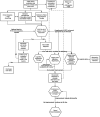A Treatment Algorithm for High-Tone Pelvic Floor Dysfunction
- PMID: 38387036
- PMCID: PMC10953682
- DOI: 10.1097/AOG.0000000000005536
A Treatment Algorithm for High-Tone Pelvic Floor Dysfunction
Abstract
Objective: To develop evidence- and consensus-based clinical practice guidelines for management of high-tone pelvic floor dysfunction (HTPFD). High-tone pelvic floor dysfunction is a neuromuscular disorder of the pelvic floor characterized by non-relaxing pelvic floor muscles, resulting in lower urinary tract and defecatory symptoms, sexual dysfunction, and pelvic pain. Despite affecting 80% of women with chronic pelvic pain, there are no uniformly accepted guidelines to direct the management of these patients.
Methods: A Delphi method of consensus development was used, comprising three survey rounds administered anonymously via web-based platform (Qualtrics XM) to national experts in the field of HTPFD recruited through targeted invitation between September and December 2021. Eleven experts participated with backgrounds in urology, urogynecology, minimally invasive gynecology, and pelvic floor physical therapy (PFPT) participated. Panelists were asked to rate their agreement with rated evidence-based statements regarding HTPFD treatment. Statements reaching consensus were used to generate a consensus treatment algorithm.
Results: A total of 31 statements were reviewed by group members at the first Delphi round with 10 statements reaching consensus. 28 statements were reposed in the second round with 17 reaching consensus. The putative algorithm met clinical consensus in the third round. There was universal agreement for PFPT as first-line treatment for HTPFD. If satisfactory symptom improvement is reached with PFPT, the patient can be discharged with a home exercise program. If no improvement after PFPT, second-line options include trigger or tender point injections, vaginal muscle relaxants, and cognitive behavioral therapy, all of which can also be used in conjunction with PFPT. Onabotulinumtoxin A injections should be used as third line with symptom assessment after 2-4 weeks. There was universal agreement that sacral neuromodulation is fourth-line intervention. The largest identified barrier to care for these patients is access to PFPT. For patients who cannot access PFPT, experts recommend at-home, guided pelvic floor relaxation, self-massage with vaginal wands, and virtual PFPT visits.
Conclusion: A stepwise approach to the treatment of HTPFD is recommended, with patients often necessitating multiple lines of treatment either sequentially or in conjunction. However, PFPT should be offered first line.
Copyright © 2024 The Author(s). Published by Wolters Kluwer Health, Inc.
Conflict of interest statement
Financial Disclosure Michele Torosis is an advisor for Iota Bioscience and Exploramed Development. Kimberly Kenton reports receiving payment from Ethicon for expert witness testimony. Rhonda Kotarinos is a contributor to UpToDate. Erin Carey reports providing expert witness testimony unrelated to this work for McEwan, Martinez, Dukes & Hall, P.A.; BeytinMcLaughlin; Massy & Associates; Wallach; McBrideHall; and Davis Wright Tremaine, LLP. She received payments from Med IQ for providing education on endometriosis. She holds two patents held by UNC remote from commercialization. Neither is licensed and neither is evaluated or considered in this Delphi review. No payment, royalties, or honoraria were received or planned from them in the next 12 months: 1) PCT International PCT/US20/55816, a drug delivery system for vulvodynia symptoms in women; and 2) PCT/US2023/016013, a device for pelvic floor dysfunction in women. She received honoraria for Grand Rounds from LSU (5/2023) and USF (4/2023). She is an International Pelvic Pain Society Immediate past president. H. Henry Lai disclosed money was paid to his institution from the NIH and Metronic. He received payment from Neuspera. He has relationships with Astella, IronWood, BioHaven, Aquinox, Teva, and MicroGenDx. Jerry Lowder reports money was paid to their institution from the NIH-NIDDK. They also received payment as an expert witness. Melanie Meister reports receiving payment from AbbVie, Inc. A. Lenore Ackerman receives grant funding from Medtronic, Inc. and MicrogenDx. Dr. Ackerman is an advisor for AbbVie and Watershed Medical. The other authors did not report any potential conflicts of interest.
Figures


References
-
- Bedaiwy MA, Patterson B, Mahajan S. Prevalence of myofascial chronic pelvic pain and the effectiveness of pelvic floor physical therapy. J Reprod Med 2013;58:504–10. - PubMed

